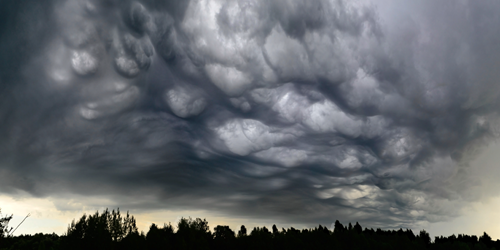Fluid Dynamics of Clouds
To predict weather and climate patterns, meteorologists use computationally intensive general circulation models (GCMs). These models work by solving equations describing how the fluid properties of Earth’s atmosphere evolve, but they struggle to describe one key atmospheric feature: clouds. This month, Physical Review Fluids published a collection of papers describing recent approaches to reduce uncertainty when modeling how clouds grow and interact with their surroundings. The papers are associated with invited talks presented at the mini symposium on cloud physics at the 73rd Annual Meeting of the APS Division of Fluid Dynamics.
One cloudy question concerns the rate at which cumulus clouds mix with, or entrain, the surrounding air and moisture as they form. Evidence from airborne measurements suggests that the best way to describe this process is as a sequence of air columns that develop over time: each column, or thermal, rises higher into the atmosphere and contains more moisture than its predecessor. However, modeling how ambient conditions influence moisture uptake in these clouds, and thus the clouds’ climate effect, has proved very difficult. Ravichandran at the Nordic Institute for Theoretical Physics, Sweden, and G. R. Vybhav at the Jawaharlal Nehru Centre for Advanced Scientific Research, India, now show how entrainment rates differ for dry and moist thermals that grow into cumulus clouds [1].
To tease out the factors that control the amount of water entrained, Ravichandran and Vybhav performed numerical simulations of thermals rising in atmospheres with different temperature and density profiles. They simulated dry and moist thermals with laminar- and turbulent-flow behaviors. The duo found that the entrainment rate increases for thermals that become more buoyant. Such buoyancy change could be due to heating from condensation or to the unstable stratification of the surrounding atmosphere. In moist thermals, this enhanced buoyancy increases the intensity of turbulence. The researchers concluded that turbulence becomes important for entrainment when initially dry thermals become moist. In contrast to previous work, they showed that moist thermals result in larger cumulus clouds than those that occur with dry ones.
In a separate study, Ravichandran and Rama Govindarajan, who is at the International Centre for Theoretical Sciences, India, explain a distinctive cloud type that was officially designated by the World Meteorological Organization in 2017 [2]. Researchers initially proposed that so-called asperitas clouds—rippling, wave-like structures that look like a rough sea surface viewed from below—originate from differential shearing in stratified cloud layers. Instead, Ravichandran and Govindarajan suggest that these clouds form when settling and evaporation of water droplets drive an instability in the cloud layers. Their models show that for certain droplet sizes and atmospheric liquid-water contents, a layer of dense air forms and becomes unstable. Small-scale turbulence driven by droplet evaporation would ordinarily disperse this layer, but when the turbulence is suppressed by background shearing, the dense layer persists, giving rise to the unique asperitas structures as the dense layer settles through the less-dense layer below.
In another paper, Tianhong Huang and his colleagues at the University of Wisconsin-Madison describe a simulation framework that could help account for the vast range of spatial scales present in patterns of cloud distribution. Reproducing this range in climate models is difficult, causing uncertainties in the models’ predictions [3]. The researchers develop simulations based on cloud clusters whose sizes and shapes are determined stochastically. In the numerical simulations, the clouds automatically evolve to fit the scale of the simulation’s grid spacing and thus can be incorporated more easily into general models. The results show a new possibility for predicting how clouds influence climate in idealized climate change simulations.
–Rachel Berkowitz
Rachel Berkowitz is a Corresponding Editor for Physics Magazine based in Vancouver, Canada.
References
- G. R. Vybhav and S. Ravichandran, Phys. Rev. Fluids 7, 050501 (2022).
- S. Ravichandran and R. Govindarajan, Phys. Rev. Fluids 7, 010501 (2022).
- T. Huang et al., Phys. Rev. Fluids 7, 010502 (2022).




